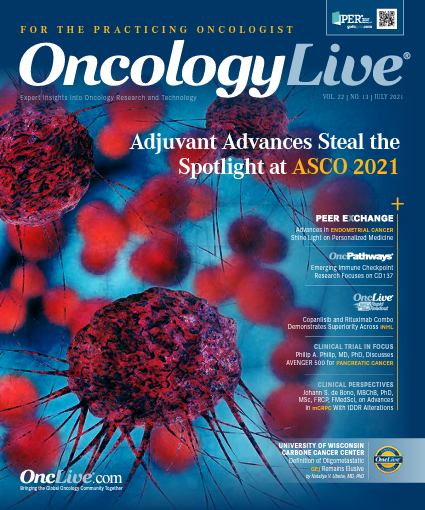Publication
Article
Adjuvant Advances Shine at ASCO 2021
Author(s):
Novel therapeutic strategies are poised to expand in adjuvant settings for patients with early-stage disease facing recurrence risks in the treatment paradigms for a range of tumor types after positive data from large phase 3 clinical trials were highlighted at the 2021 American Society of Clinical Oncology Annual Meeting
Julie R. Gralow, MD, FACP, FASCO

Novel therapeutic strategies are poised to expand in adjuvant settings for patients with early-stage disease facing recurrence risks in the treatment paradigms for a range of tumor types after positive data from large phase 3 clinical trials were highlighted at the 2021 American Society of Clinical Oncology Annual Meeting (ASCO 2021).
The new findings establish an earlier role for therapies introduced for metastatic disease, but experts say that uptake in clinical practice will depend upon the perceived benefits of adjuvant treatment compared with the toxicities and the costs of additional therapy.
From a clinical standpoint, ASCO 2021 featured results of studies showing that adjuvant therapy could enhance disease-free survival (DFS) vs placebo or best supportive care for subsets of patients with breast, lung, and renal cell carcinoma. Key findings were reported from these studies (TABLE1-4):
- OlympiA (NCT02032823)—The PARP inhibitor olaparib (Lynparza) significantly improved 3-year invasive DFS to 85.9% compared with 77.1% with placebo in patients with HER2-negative breast cancer harboring a germline BRCA1/2 mutation that was deemed high risk after primary local treatment and neoadjuvant or adjuvant therapy.1
- IMpower010 (NCT02486718)— Atezolizumab (Tecentriq), a PD-L1 immune checkpoint inhibitor, demonstrated a 34% reduction in the risk of disease recurrence or death (HR, 0.66; 95% CI, 0.50-0.88) compared with best supportive care (BSC) among patients with resected PD-L1–positive stage II to IIIA non–small cell lung cancer (NSCLC).2
- KEYNOTE-564 (NCT03142334)— Pembrolizumab (Keytruda), a PD-1 inhibitor, showed a 24-month estimated DFS rate of 77.3% compared with 68.1% with placebo in patients with clear-cell renal cell carcinoma (RCC) categorized as intermediate high risk or high risk after nephrectomy. Investigators also observed a preliminary trend toward an overall survival (OS) benefit of 96.6% with pembrolizumab vs 93.5% with placebo.3
The emphasis on the adjuvant setting underscores the importance of developing therapies that can improve outcomes for patients who face a high residual risk of recurrence after primary treatment, according to Julie R. Gralow, MD, FACP, FASCO, chief medical officer and executive vice president of ASCO. “This is a population [for which] for many cancers, we don’t have a high likelihood of cure,” Gralow said in an interview with OncologyLive®. “We’re looking for something that can add benefit. We’re also testing risk vs benefit.”
In that regard, negative results from an adjuvant therapy trial in cervical cancer were highlighted along with positive adjuvant data during the conference’s plenary session. Findings from the international phase 3 OUTBACK trial (ACTRN12610000732088) demonstrated that administering chemotherapy to patients with locally advanced cervical cancer following standard cisplatin-based chemoradiation resulted in similar progression-free survival without improving OS at 5 years (HR, 0.91; 95% CI, 0.70-1.18).4
TABLE. Select Adjuvant Therapy Phase 3 Trial Findings Presented at ASCO 2021

“It’s not often that we pick a negative trial to put in the plenary session, but because this group of patients with locally advanced cervical cancer has a rate of high relapse… [clinicians] have been adding chemotherapy thinking more must be better,” Gralow said. “It’s important to show chemotherapy isn’t the answer. Now we need to think outside the box.”
Overall, the expansion of adjuvant therapies is indicative of the trend toward individualizing treatment, accord-ing to Erika P. Hamilton, MD, director of the breast cancer and gynecologic cancer research program at Sarah Cannon Research Institute of Tennesse Oncology in Nashville. “I think this is really kind of the next wave of personalized medicine,” she said in an OncLive® NewsNetwork: On Location interview.
DFS SERVES AS END POINT
Erika P. Hamilton, MD

The findings that form the underpinnings of the OlympiA, IMpower010, and KEYNOTE-564 trials hinge on DFS, an end point that the FDA and clinical guidelines recognize. The FDA has approved the use of DFS as an end point for accelerated and traditional adjuvant therapy approvals for stage III NSCLC and following complete resection for 6 solid tumor types: colon, colorectal, and breast cancer; RCC; melanoma; and gastrointestinal stromal tumor.5
Nevertheless, the development of therapies in the adjuvant setting has proceeded comparatively slowly. In an analysis published in JAMA Network Open in April 2020, investigators identified 69 agents that the FDA approved or the National Comprehensive Cancer Network guide-lines recommended for use in the metastatic setting for patients with NSCLC, breast, and colon cancers as of May 15, 2019, compared with 25 therapies for adjuvant use. For drugs approved or recommended in both settings, the mean delay in moving a therapy from the metastatic to the adjuvant setting was 10 years (SD, 7.5).6
Challenges to developing adjuvant therapy include identifying the patient population likely to benefit, recruiting enough patients for meaningful comparisons, and determining whether the improvement in outcomes justifies the added toxicity, Gralow said.
Meanwhile, the extent to which adjuvant approaches are embraced in clinical practice may vary. Oncologists who treat patients with breast cancer, for whom investigators pioneered the use of adjuvant strategies in the 1970s,7 are familiar with such approaches whereas those who specialize in other malignancies may not be. “If it’s a cancer type [with which] most patients do well and cure is highly likely, it’s going to take a lot to convince [oncologists] to add something more. I think we’ve had a lot of dialogue in this meeting on exactly how we relate to our patients and [explain] what their actual risk of recurrence is,” Gralow said.
A decision to recommend adjuvant therapy is “all about precision medicine,” she continued. “You have to understand the cancer, you have to understand features of the patient. And then you have to look at the features of the therapy. They all have to come together for [adjuvant therapy] to make sense. That’s where I think we’re going.”
OLAPARIB IN BREAST CANCER
Judy E. Garber, MD, MPH

In OlympiA, investigators recruited 1836 patients with HER2-negative breast cancer who had high-risk stage II or III disease or failed to achieve a pathologic complete response to neoadjuvant chemotherapy and whose tumors had a germline BRCA1/2 mutation. All participants except 2 in the placebo arm underwent primary surgery (either a mastectomy or conservative surgery) with adjuvant (50%) or neoadjuvant (50%) chemotherapy. Investigators randomized participants to receive either olaparib at 300 mg twice daily or placebo for 1 year.1
In the intent-to-treat (ITT) population, olaparib therapy resulted in an absolute difference in the 3-year invasive DFS rate of 8.8% (95% CI, 4.5%-13.0%), which translated into a 42% reduction in the risk of disease recurrence or death (HR, 0.58; 99.5% CI, 0.41-0.82; P < .0001.). Treatment with olapa-rib also improved distant DFS vs placebo (HR, 0.57; 99.5% CI, 0.39-0.83; P < .0001). Notably, investigators also observed a trend toward improved OS in the olaparib arm, with a 92.0% rate vs 88.3% with placebo (stratified HR, 0.68; 99.5% CI, 0.44-1.05; P = .024). However, the OS was not statistically significant given the median follow-up of only 2.5 years and a prespecified threshold of P < .01. Blinded follow-up continues.
In terms of tolerability, the incidence of all-grade adverse events (AEs) was greater with olaparib than placebo, including for nausea (57% vs 23%, respectively), fatigue (40% vs 27%), and anemia (23% vs 4%). However, olaparib did not increase the incidence of serious AEs compared with placebo (8.7% vs 8.4%, respectively), or AEs of special interest (3.3% vs 5.1%, respectively).
The findings mark the first time that results were reported for adjuvant PARP inhibition in this population, investigators said. The trial “changes care for women who have a possibility of having a germline mutation,” Judy E. Garber, MD, MPH, a leading OlympiA investigator, said in an interview. “These treatments should be different” for these patients.
“It does mean we have to think more about how to manage genetic testing in our patients at high risk,” added Garber, chief of the Division for Cancer Genetics and Prevention and Susan F. Smith Chair at Dana-Farber Cancer Institute in Boston, Massachusetts. “[For] those patients who would have been eligible for the trial, we should be thinking, is this someone who might have a mutation. That means people have to devise ways to get genetic testing done.”
BRCA testing is not routinely conducted for patients with earlystage breast cancer but “there will certainly be a push” to expand testing in this setting as a result of the OlympiA findings, according to Cathy Su, PhD, a consultant in oncology and specialty therapeutics at Kantar Health, a research and analytical company in New York, New York.8
Expanded testing and adjuvant olaparib therapy has the potential to affect a large pool of patients. Overall, more than 475,000 patients with early-stage HER2negative breast cancer will be treated this year with neoadjuvant or adjuvant therapies in the United States and other G8 countries, according to Kantar.8
“The cost of these drugs will affect how well they are adopted in the wealthy countries as well as the poorer countries,” Garber observed. “It would be a shame to show that the drugs are effective and not be able to make them available.”
To Hamilton and Garber, the OlympiA findings are part of a continuing expansion of adjuvant therapies for patients with breast cancer.
“We are learning in breast cancer care that adding additional adjuvant therapies is a really good way to right-size therapy for our patients,” Hamilton said. “Probably a great example of this was the KATHERINE data [NCT01772472]. We had some lukewarm results in the HER2 [population] but KATHERINE came along with a great trial design, taking those patients who were high risk based on the fact that they did not have a pathologic complete response to good therapy, and we saw an 11% improvement in DFS when we added T-DM1 [ado-trastuzumab emtansine; Kadcyla].9 OlympiA is the same. It’s taking patients who have a known predictor here, the germline BRCA mutation, and offering them an additional therapy for improvement.”
“Adjuvant therapy is the treatment that transformed breast cancer from a more often fatal disease to a potentially curable one,” Garber observed. “But the responsibility in adjuvant therapy is to identify those patients who will most benefit from the intervention and to target therapies appropriately, to forgo toxic treatments in patients who don’t need them. Fortunately, we’re at the place in breast cancer where that’s the tension—we’re trying to match more aggressive treatments in patients who need them and to back off more toxic treatments in patients who can do without them. That’s a good place to be. That says you have success.”
ATEZOLIZUMAB IN NSCLC
Heather Wakelee, MD

In NSCLC, adjuvant platinum-based chemotherapy has been integrated into the treatment paradigm for patients with completely resected stage IB to IIIA disease for more than 15 years, demonstrating a 4% to 5% OS improvement over observation.2 In December 2020, the FDA approved osimertinib (Tagrisso) as adjuvant therapy after tumor resection for patients with NSCLC that harbors EGFR exon 19 deletions or exon 21 L858R mutations after the third-generation EGFR inhibitor showed a substantial improvement in median DFS over placebo (HR, 0.17; 95% CI, 0.12-0.23; P < .0001) in the ADAURA trial (NCT02511106).10
Meanwhile, the PD-L1 inhibitor durvalumab (Imfinzi) has emerged as an adjuvant option for unresectable stage III disease following its February 2018 approval for patients whose cancer has not progressed after concurrent platinum-based chemoradiation.11
In IMpower010, investigators sought to expand the benefits of immunotherapy to patients with stage IB to IIIA disease who had undergone complete tumor resection followed by chemotherapy with cisplatin plus pemetrexed (Alimta), gemcitabine, docetaxel, or vinorelbine for 1 to 4 cycles. Following those treatments, 1005 patients were then randomized to receive either atezolizumab at 1200 mg every 21 days for 16 or BSC.
Participants were stratified by PD-L1 expression status at study entry. Primary end points were DFS in patients with stage II to IIIA disease with PD-L1 expression on 1% or more of tumor cells; all randomized patients in the stage II to IIIA cohort; and the ITT population with stage IB to IIIA disease.2
After a median follow-up of 32.8 months, atezolizumab therapy proved most effective for participants with stage II to IIIA disease with PD-L1 expression of 1% or more on tumor cells. The median DFS was not estimable (NE; 95% CI, 36.1-NE) among participants in this cohort (n = 248) compared with 35.3 months (95% CI, 29.0-NE) for those who received BSC (n = 228), which translated to an HR of 0.66 (95% CI, 0.49-0.87; P = .004). For all randomized patients with stage II to IIIA disease, the HR was 0.79 (95% CI, 0.64-0.96; P = .02). In the ITT population, the DFS did not cross the threshold for statistical significance (HR, 0.81; 95% CI-0.67-0.99; P = .04).
In terms of toxicities, investigators found that the safety profile of atezolizumab was consistent with prior studies of the drug in more advanced disease settings. The incidence of grade 3/4 AEs was 21.8% in the atezolizumab arm and 11.5% in the BSC group. In all, 67.7% of those who received immunotherapy experienced treatment-related AEs (TRAEs), including 7.5% with serious TRAEs. There were 8 deaths among patients who received atezolizumab, including 4 attributable to TRAEs, compared with 3 deaths on the BSC arm. Grade 5 events in the atezolizumab population included interstitial lung disease, multiple organ dysfunction syndrome, myocarditis, and acute cardiac failure.
The findings show that “atezolizumab may be considered a practice-changing adjuvant treatment option for patients with resected PD-L1–expressing stage II to IIIA non-small cell lung cancer,” lead study author Heather Wakelee, MD, a professor of medicine at Stanford University Medical Center in California, said in presenting the results.
The study will continue for DFS and OS analyses in the ITT population, Wakelee said. At the time of her presentation, OS data were immature and not formally tested, although early findings favor atezolizumab therapy in the PD-L1–positive stage II to IIIA population.
The IMpower010 findings are “compelling,” Edward S. Kim, MD, MBA, said in an OncLive® NewsNetwork: On Location interview. “We all have this gut feeling that if we can do something more that has some benefit, we will help folks,” said Kim, physician in chief of City of Hope Orange County and vice physician in chief of City of Hope National Medical Center in California. “We largely learned from colon cancer and breast cancer that longer-term biologic-type therapy may help and we do see that in this study. This study will change how we approach lung cancer, especially those surgically resected, curative-intent patients.”
The results may hold the potential for a narrow adjuvant indication for atezolizumab, according to Stephanie Hawthorne, vice president of oncology and specialty therapeutics at Heather Wakelee, MD Kantar Health.12 The agent currently is approved in several first-line and recurrent settings for patients with metastatic NSCLC.13
Edward S. Kim, MD, MBA

Looking forward, Hawthorne noted that investigators are testing adjuvant immunotherapy for NSCLC in several other large clinical trials. “IMpower 010 is the first to report positive results in the postsurgical setting,” she said. “Learnings from this trial, especially how the oncology community and regulatory bodies perceive this level of evidence, is going to provide critical insights for the pharma industry that is also working to develop in this space.”
For his part, Kim feels that the emphasis on early-stage settings that IMpower010 exemplifies represents “movement in the right direction.”
“We need to be receptive to allowing these types of therapies to be studied and to be approved quickly for patients,” he said. “We all want there to be safety—that absolutely has to be the case—but this is why we do informed consent, this is why we talk to the patients. Accelerating these drugs is even more important in a curative-intent population because these are patients that we’re trying to keep their disease away and this way we build long-term survivors.”
PEMBROLIZUMAB FOR RCC
Although locoregional RCC is typically treated with curative-intent nephrectomy, nearly half of patients eventually experience disease recurrence, according to Toni K. Choueiri, MD, lead author of the KEYNOTE-564 study. “Currently, there is no globally accepted standard-of-care therapy to delay disease progression after surgery,” Choueiri said in presenting the findings at ASCO 2021. “Cytokines and VEGF-targeted agents have not shown much consistent benefit in this setting.”
For KEYNOTE-564, investigators recruited patients with clear cell RCC who had undergone nephrectomy within 12 weeks of randomization without prior systemic therapy. In all, 994 patients were randomized to receive pembrolizumab at 200 mg every 3 weeks for approximately 1 year or placebo.
Toni K. Choueiri, MD

Stratification factors included stage M0 cancer vs M1 with no evidence of disease (NED). The pembrolizumab and placebo arms were well-balanced for disease risk categories, respectively, for M0 intermediate-high risk (86.1% vs 86.9%), M0 high risk (8.1% vs 7.2%), and M1 NED (5.8% vs 5.8%).
Investigator-assessed DFS was the primary end point of the trial. At 24 months, the DFS rate was 77.3% for patients who received pembrolizumab compared with 68.1% for those who had placebo, for an HR favoring immunotherapy of 0.68 (95% CI, 0.53-0.87; P = .0010). The median DFS was not reached in either arm. “The difference with pembrolizumab vs placebo was statistically significant,” said Choueiri, director of the Lank Center for Genitourinary Oncology at Dana-Farber and the Jerome and Nancy Kohlberg Professor of Medicine at Harvard Medical School in Boston. “The curve split early on, with an estimated difference in DFS rate of about 10% for pembrolizumab vs placebo at the key time points of 12 and 24 months.”
Interim OS results also favored pembrolizumab (HR, 0.54; 95% CI, 0.030-0.96; P = .0164), although only about 25% of events needed for analysis had occurred at the time of data cutoff.
In terms of safety, Choueiri said AEs with pembrolizumab fit the known profile for the drug and were manageable. TRAEs were higher with pembrolizumab compared with placebo for frequently observed events including fatigue (20.3% vs 14.3%, respectively), pruritus (18.6% vs 11.5%), hypothyroidism (17.6% vs 2.6%), and diarrhea (15.8% vs 10.3%). Grade 3 to 5 TRAEs also were more prevalent with pembrolizumab (18.9% vs 1.2%).
Putting the results into context for patients with the malignancy, Choueiri added a personal observation.
“The first randomized controlled trial, to my knowledge, of adjuvant immunotherapy in renal cell cancer was with interferon,” he said. “And this was presented at the 1992 ASCO meeting. At that time, I wasn’t done with high school. Now 29 years later, finally, f inally, we have a positive adjuvant study in renal cell cancer, a positive adjuvant study of immunotherapy with pembrolizumab. It took a whole generation to achieve this goal.”
References
- Tutt A, Barber JE, Kaufman B, et al. OlympiA: a phase III, multicenter, randomized, placebo-controlled trial of adjuvant olaparib after (neo)adjuvant chemotherapy in patients with germline BRCA1/2 mutations and high-risk HER2-negative early breast cancer. J Clin Oncol. 2021;39(suppl 15):LBA1. doi:10.1200/JCO.2021.39.15_suppl.LBA1
- Wakelee HA, Altorki NK, Zhou C, et al. IMpower010: primary results of a phase III global study of atezolizumab versus best supportive care after adjuvant chemotherapy in resected stage IB-IIIA non-small cell lung cancer (NSCLC). J Clin Oncol. 2021;39(suppl 15):8500. doi:10.1200/JCO.2021.39.15_suppl.8500
- Choueiri TK, Tomczak P, Park SH, et al. Pembrolizumab versus placebo as post-nephrectomy adjuvant therapy for patients with renal cell carcinoma: randomized, double-blind, phase III KEYNOTE-564 study. J Clin Oncol. 2021;39(suppl 15):LBA5. doi:10.1200/JCO.2021.39.15_suppl.LBA5
- Mileshkin LR, Moore KN, Barnes E, et al. Adjuvant chemotherapy following chemoradiation as primary treatment for locally advanced cervical cancer compared to chemoradiation alone: the randomized phase III OUTBACK trial (ANZGOG 0902, RTOG 1174, NRG 0274). J Clin Oncol. 2021;39(suppl 15):LBA3. doi:10.1200/JCO.2021.39.15_suppl.LBA3
- Table of surrogate endpoints that were the basis of drug approval or licensure. FDA. Updated March 31, 2021. Accessed June 14, 2021. https://bit.ly/2RRbPgU
- Parsons S, Maldonado EB, Prasad V. Comparison of drugs used for adjuvant and metastatic therapy of colon, breast, and non–small cell lung cancers. JAMA Netw Open. 2020;3(4):e202488. doi:10.1001/jamanetworkopen.2020.2488
- Burotto M, Wilkerson J, Stein WD, Bates SE, Fojo T. Adjuvant and neoadjuvant cancer therapies: a historical review and a rational approach to understand outcomes. Semin Oncol. 2019;46(1):83-99. doi:10.1053/j.seminoncol.2019.01.002
- Su C. OlympiA: a phase III, multicenter, randomized, placebo-controlled trial of adjuvant olaparib after (neo)adjuvant chemotherapy in patients with germline BRCA1/2 mutations and high-risk HER2-negative early breast cancer. June 7, 2021. Accessed June 14, 2021. https://bit.ly/3pQDzPt
- Kadcyla. Prescribing information. Genentech; 2020. Accessed June 15, 2021. https://bit.ly/2S22pzq
- FDA approves osimertinib as adjuvant therapy for non-small cell lung cancer with EGFR mutations. FDA. December 18, 2020. https://bit.ly/2TCwZA5
- FDA approves durvalumab after chemoradiation for unresectable stage III NSCLC. FDA. Updated February 20, 2018. https://bit.ly/3xjYbC2
- Hawthorne S. IMpower010: primary results of a phase III global study of atezolizumab versus best supportive care after adjuvant chemotherapy in resected stage IB-IIIA non-small cell lung cancer (NSCLC). June 7, 2021. Accessed June 16, 2021. https://bit.ly/3glIggQ
- Tecentriq. Prescribing information. Genentech; 2021. Accessed June 16, 2021. https://bit.ly/3vwij2L










